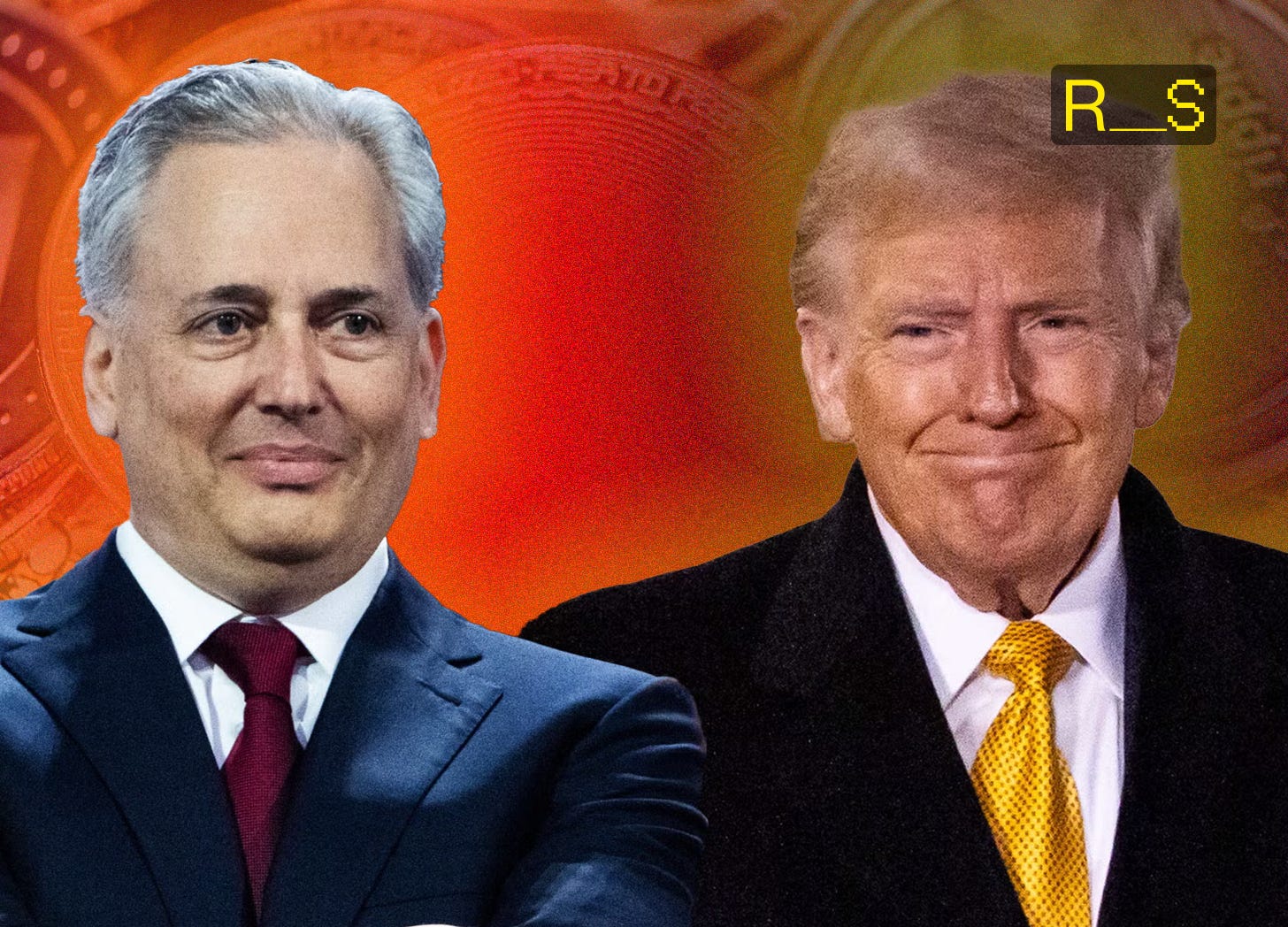Trump’s Bitcoin Reserve & Crypto Stockpile: Innovation or the Ultimate Grift? What are the Long-Term Implications?
Is President Trump’s pro-crypto play a fast-path to corruption or an overdue embrace of a maligned technology? Here's a full breakdown, including hypothetical corruption scenarios & past precedents.
On March 2, President Donald Trump announced by “truth” that a crypto reserve which would feature the cryptocurrencies Ripple (XRP), Solana (SOL), and Cardano (ADA). In a later post he added that Bitcoin (BTC) and Ethereum (ETH) would be included as well. This was historic news—I knew it immediately, and said so in my flash analysis that day.
As more has been revealed—including the White House Crypto Summit on March 7—I’ve had a chance to conduct a deeper analysis. What follows is designed for those with no understanding of crypto to grasp the basic ideas. To clarify: I’m not going to explain how blockchain technology works other than where necessary, but if you want an accessible explainer, I like this one from Reuters.
Some background for folks who may not know: I’ve been covering emerging technologies, including cryptocurrencies, since 2015. In Decemeber 2017, my articles about cryptocurrencies in Forbes accounted for 5% of all of Forbes.com site traffic. I curated the first-ever museum retrospective on the history of NFTs, and most recently worked as Arts & Culture advisor for Protocol Labs, an open-source research & development company whose key projects include IPFS and Filecoin.
Okay, let’s get to it.
What is the Trump Crypto Reserve, and What Has Happened so Far?
In his March 2 announcement, President Donald Trump framed the crypto reserve as a move to “elevate this critical industry after years of corrupt attacks by the Biden Administration” and to make the U.S. “the Crypto Capital of the World.”
Though it hasn’t been implemented yet, other than the Bitcoin reserve described below, such a reserve would in theory use taxpayer dollars to buy the digital assets named above, marking a dramatic shift in U.S. financial policy (to put it lightly).
Critics immediately noted that this initiative “poses countless conflicts of interest—especially for Trump himself,” essentially amounting to a taxpayer-funded gift to the crypto industry.
This move appeared to make good on then-candidate Trump’s July 2024 campaign promise to create a “strategic national bitcoin reserve.”
The announcement triggered a trading frenzy, driving up the named coins’ prices (Bitcoin jumped over 10% and Cardano surged by nearly 70% that day), though they have all since fallen below their early March prices.
Executive Order
On Thursday, March 6, President Trump issued an executive order establishing a government stockpile of bitcoin. The move is more for show than anything; under the EO, the U.S. government will simply retain the estimated 200,000 bitcoin it has already seized in criminal and civil proceedings, according to Trump’s “crypto czar” David Sacks (who we’ll be discussing in more detail below).
With this EO, the White House appeared to adjust course, holding the bitcoin-only strategic reserve alongside a separate crypto stockpile comprised of ADA, ETH, SOL, and XRP.
In a March 7 episode of the All-In podcast, Sacks explained that the Bitcoin reserve would be moved “to the digital stockpile,” and that “the purpose of the stockpile is responsible stewardship, it’s a place for safekeeping, it’s a centralized account under the direction of the secretary of the Treasury and the secretary of the Treasury will figure out how to maximize the value of these holdings.”
White House Crypto Summit
On March 7, the White House hosted the first-ever “crypto summit,” bringing together key industry figures from Coinbase, Ripple, Gemini, Kraken, Chainlink, and Robinhood, emphasizing the administration’s intent to foster growth and innovation in the sector through clearer regulatory frameworks.
“Last year I promised to make America the Bitcoin superpower of the world and the crypto capital of the planet, and we're taking historic action to deliver on that promise,” Trump said in his address.
Trump also confirmed his commitment to bitcoin—seeming to elevate it to a position above other cryptocurrencies—in a reserve described as a “digital Fort Knox,” in a nod to the U.S. gold reserve.
Advocates, epitomized by the industry leaders in attendance at the summit, believe this crypto reserve is a chance to fortify U.S. economic supremacy worldwide.
“My job is not to encourage people to buy crypto. My job is to create an innovation framework for the United States,” Sacks said, adding that “we’re only allowed to buy more [cryptocurrencies] if it doesn’t add to the deficit or the debt or cost taxpayers,” seeming to address the concerns that taxpayer dollars would be used to build either the Bitcoin reserve or crypto stockpile.
Trump also later framed the move as a means of competing with China in tech.
“China is pushing forward very strongly as usual, but we're way in the lead, as we are in AI and other things, and we want to stay there,” Trump said.
Crypto Contraction
The initial trading frenzy after the March 2 announcement has died down—and the crypto market has continued to tumble, falling to its lowest market capitalization since the post-election surge.
Agne Linge, head of growth at crypto platform WeFi, told Forbes that the more constrained approach of the bitcoin reserve may have cooled short-term enthusiasm, while leaving the door open for long-term growth through geopolitical implications:
“The subpar strategic bitcoin reserve move triggered the uncertainty in the crypto market…. With the executive order directing agencies to consolidate seized bitcoin to form the reserve, crypto investors see the move as a trick, as no new bitcoin purchase was announced. Despite the knee-jerk reaction from investors, the fact is that the bitcoin reserve mandate authorizes the acquisition of bitcoin through means that will not cost taxpayers’ money. The available options in this regard include bitcoin bonds and the sales of its gold reserve to fund more purchases. In the long term, the bitcoin reserve shift might benefit the coin. This thesis hinges on a possible race it has triggered that may see other sovereign nations make similar moves.”
Blockchain Technology: Ideals vs. Realities
Blockchain and cryptocurrencies are not de facto bad or evil. The baseline of cryptography, distributed ledgers, and decentralized consensus protocols is rooted in worthy ideals—namely that of putting power in the hands of collectives rather than the centralized individuals and entities (which increasingly concentrate power).
Unfortunately, the confusing and unregulated “wild west” aspects of the technology also make it an ideal zone for graft, fraud, and ransoms (e.g., cyberattacks on hospitals frequently involve ransom payments in cryptocurrencies because they are easier to send without oversight and harder to track and retrieve once disbursed).
I resonate with something that Urgent Futures podcast
quipped, which is that the more boring the use case, the more likely blockchain is good for it.Eric Czuleger: What's...a Country?
Welcome to the Urgent Futures podcast, the show that finds signal in the noise. Each week, I sit down with leading thinkers whose research, concepts, and questions clarify the chaos, from culture to the cosmos.
As authoritarian regimes intensify around the world, for example, blockchain technologies could prove invaluable for preserving evidence of war crimes for posterity—a use case demonstrated by Starling Lab.
But there’s two sides to that coin. Cryptocurrencies also offer sneaky and expedient means for committing crimes for those very same authoritarian regimes.
Conflicts of Interest and Self-Dealing
Following the March 2 announcement, observers quickly pointed out that Trump’s crypto reserve could enrich Trump and his family.
Paid subscribers can access the following content below:
Conflicts of Interest and Self-Dealing
Why is the Crypto Reserve Ripe for Corruption?
Hypothetical Abuse Scenarios of the Crypto Reserve
Systemic Issues: Political Corruption with Crypto
Who is David Sacks? Trump’s “Artificial Intelligence and Crypto Czar”
How Trump Allies and the Crypto Community Responded to the Trump Crypto Reserve
Comparisons to Past Precedents






